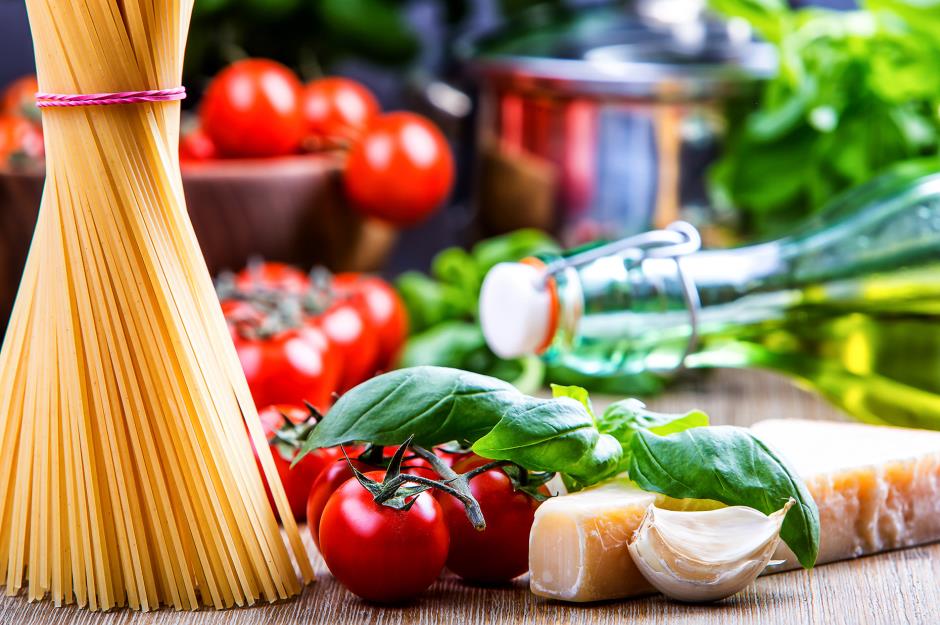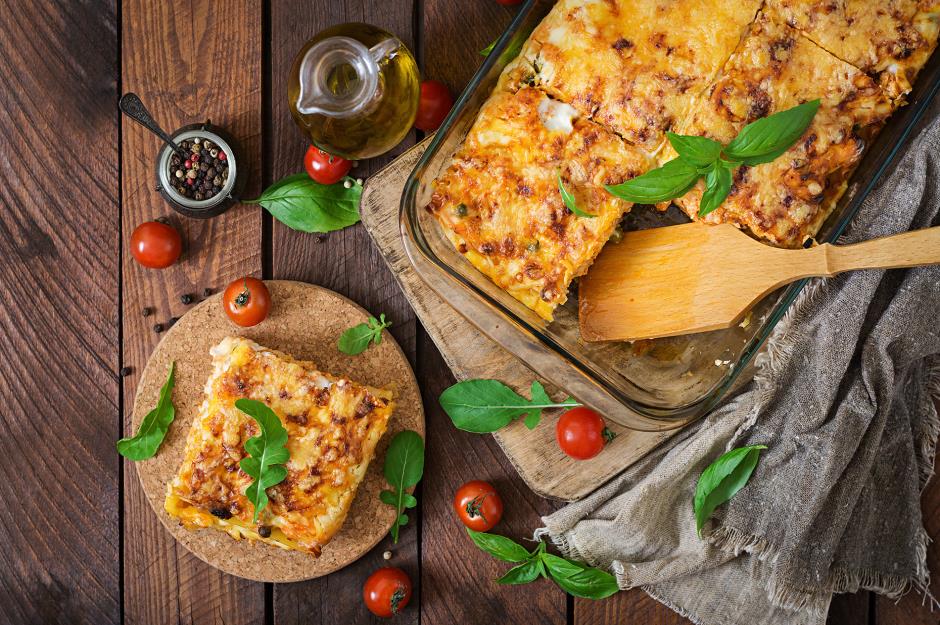The Italian dishes everyone should know how to cook
Recipes straight from mamma’s kitchen
When we think of Italian cuisine, we immediately imagine the full-bodied smell of a tomato sauce bubbling on the stove, the salty taste of freshly sliced prosciutto, and lots and lots of cheese, from soft and creamy mozzarella to sharp and nutty Parmigiano-Reggiano. The Italian no-nonsense attitude to food is rooted deep down in their kitchen culture, and knowing how to cook at least a few authentic Italian dishes is a must for any home cook.
Lasagne al forno
A popular comfort food around the world, lasagne’s thick meat ragù and creamy béchamel sauce, squeezed in-between thin layers of pasta sheets, is a taste everyone recognises. Created during the Middle Ages, the origins of lasagne are traditionally ascribed to Naples, however their version of lasagne di carnevale is less known than the more common lasagne al forno. This simple recipe is one of our favourites.
Spaghetti alla carbonara
Carbonara, borrowing its name from Laziali coal men called carbonari, who brought it to Rome from Umbria, has always been subject to controversy. Locals are often infuriated by foreigners’ use of milk or cream to thicken the sauce, or if they let the eggs become scrambled – both unacceptable if you’re looking to make an authentic Italian carbonara. The traditional sauce is simply made with eggs, pancetta, black pepper and hard cheese, such as pecorino or Parmesan, and served with spaghetti.
Pizza margherita
If you’re a fan of pineapple on your pizza, or prefer deep-dish, turn away now. Created by Raffaele Esposito in 1889 in honour of the Italian flag and named after Margherita di Savoia, an authentic margherita is only made from a simple fresh tomato sauce, mozzarella and basil. Pizza Pilgrims' recipe is one of the best.
Insalata caprese
This simple salad of sliced ripe tomato, sliced fresh mozzarella and green basil is traditionally only seasoned with salt and olive oil. In Italy, this Campanian dish from the Isle of Capri is usually served as an antipasto (starter) to celebrate the rich flavours of fresh produce.
Panna cotta
Literally meaning ‘cooked cream’, panna cotta is the simplest of deserts. Originally made just with cream, sugar and gelatine, an excellent panna cotta is defined by the right amount of wobble and is usually served with strawberry or raspberry coulis. If you're making it for the first time, Lawrence Dallaglio's recipe is a great place to start.
Tiramisu
The popular Italian ‘pick me up’ is a rich dessert, blending the deep flavours of coffee and cocoa. Traditionally, it’s made of sponge fingers called savoiardi dipped in coffee, then layered with a whipped mixture of eggs, sugar and mascarpone, but modern variations include the addition of Marsala, chocolate or berries. Try this 25-minute version for your next dessert.
Pasta con pomodoro e basilico
Gelato
Gelato is just the Italian word for ice cream, right? Wrong. Italians are very strict about what counts as gelato – it must be made from milk, cream, sugar and flavoured with fruit and nut purees. Although gelato, by Italian law, is required to have at least 3.5% butterfat, it’s lower in fat than other types of ice cream and contains less air, giving it richness. It's easier to produce at home than you might think, but you will need an ice cream maker - try this recipe for a simple introduction.
Caponata
This Sicilian aubergine dish is a perfect example of the sweet and sour tastes typical to the island. Aubergine is the star of the dish, complemented by onion, celery and tomatoes. It is enriched with salty components such as olives, capers or even anchovies, and sweetened by ingredients such as sugar, sultanas or raisins. Finally, a balancing sour ingredient, such as lemon juice or red wine vinegar is added, creating deep, rich layers of flavour.
Ravioli
Usually served in a broth or a sauce, these Italian dumplings are traditionally cut in a square shape and served as a first course. The fillings vary from region to region. In Rome, popular pairings include ricotta cheese, black pepper and spinach while Sardinian ravioli might be filled with ricotta and grated lemon peel. We also like this version with mozarella and spinach.
Parmigiana
Known around the world thanks to the popularity of chicken parmigiana, this southern Italian dish is originally vegetarian. Thin slices of pan-fried aubergine are layered with tomato sauce and cheese, and then baked before serving. It’s best enjoyed with a glass of a tangy red such as Valpolicella Ripasso.
Bruschetta
This antipasto dates as far back as medieval times – and its popularity shows no sign of abating. Although it’s enjoyed all over the world, bruschetta’s spiritual home lies in central Italy. The secret to a perfect bruschetta lies in carefully grilled bread, with just the right taste of smoke, which is rubbed with garlic and then topped with juicy ripe tomatoes. Add a glug of good olive oil, salt and basil for an authentic taste of Italy, or branch out by adding olives and oregano as in this recipe by Gennaro Contaldo.
Pappa al pomodoro
Next time you need to use up some stale bread, opt for this thick Tuscan soup. The dish translates to ‘mush of tomato’, and combines fresh tomatoes, stale bread, olive oil, garlic and basil. It can be served both hot and cold. There are several ways of cooking the soup, with more popular recipes suggesting grilling the tomatoes before boiling them down in a soup.
Crostata
The most-loved version of this baked tart, crostata di visciole, has a filling of wild sour cherries and comes from the central Italian region of Frosinone. Taking its name from the cross-like lattice, the pastry crust doesn’t change much in different recipes, however the filling varies from kitchen to kitchen and can include different fruit preserves, as well as pastry cream or ricotta.
Arancini
Back in medieval times, these rice balls were filled with a meaty ragù, peas and cheese and then deep-fried so they would be easier to carry when hunters or farmers went out to work. Today, this Sicilian finger-food has become increasingly popular in Italian street food restaurants and is often served with a tomato or béchamel sauce. Try this version with wild mushrooms next time you have leftover risotto rice.
Tortellini
Originating from the region of Emilia Romagna, tortellini are small ring-shaped pasta sheets, stuffed with meat or cheese and then folded. One legend says that they were invented by an innkeeper who, seduced by the beauty of a guest, peeked through the keyhole at night but could only see her naval, illuminated by a couple of candles in the room. It was said to inspire him to create tortellini that night, hence their shape similar to a belly button.
Gnocchi
Italians love making the most of their food and gnocchi is no exception. A smart way of using up leftover potatoes, gnocchi can be served with a wide variety of sauces. Like many Italian dishes, gnocchi recipes vary through different regions. For example, in Rome gnocchi are traditionally served on Thursdays; Fridays were fasting days with only a fish based dinner so heavy dishes such as gnocchi provided energy for the next day.
Risotto
This northern Italian dish is one of the most common ways of cooking rice in Italy. The most known variations are risotto al funghi with wild mushrooms and risotto al nero di seppia, a speciality of the Veneto region, made with cuttlefish ink to colour the risotto black. The variety of rice used in risotto is most important as it must be a short thick grain, such as arborio, that absorbs the liquid and releases starch, which helps to create the risotto’s creamy consistency. You could also try versions with pumpkin and gorgonzola, or even beetroot.
Focaccia
The commonly known focaccia al rosmarino is a flat oven-baked bread, usually seasoned with olive oil, salt and topped with rosemary. Several recipes also see the addition of olives, sun-dried tomatoes or garlic. Focaccia can also be served with slices of prosciutto or other Italian cured meats as an antipasto; this walnut focaccia recipe works particularly well.
Ossobuco alla Milanese
The key to cracking this Milanese speciality lies in the braising of the veal shin – a must in an authentic ossobuco. After slow-cooking it in a mixture of white wine and meat broth with tomatoes, celery, carrots and onions, the indulgent meat dish is served with saffron rice or risotto alla Milanese.
Panzanella
A peasant dish born out of necessity in Tuscany, panzanella is a popular salad based around stale chunks of bread soaked in water and squeezed dry. Traditionally only made with tomatoes, onions and basil, modern recipes like this one see the addition of olives, mozzarella, capers, anchovies, cucumbers and more. The secret to a good panzanella is leaving it stand for about 15 minutes so the flavours have a chance to mingle.
Ragù
A good meat ragù is the cornerstone of Italian cooking. It can be made with minced, chopped or whole cuts of meat and even offal. The meat is then combined with vegetables and sautéed in a liquid that, again, can be any combination of broth, wine, cream and tomatoes. Its most famous variation, ragù all Bolognese, more commonly known as Bolognese sauce outside Italy, is used to dress tagliatelle al ragù and to prepare lasagne alla Bolognese.
Cannoli
This Sicilian desert, perfect for ending any Italian dinner, is a popular pastry filled with a sweet, creamy ricotta. Cannoli dough is infused with cinnamon and dipped in chocolate and pistachios once deep-fried.
Bistecca alla Fiorentina
More familiar to most as Florentine steak, this is one of the glories of Tuscan cuisine; any Tuscan home cook will tell you that they make the best. The thick slice of T-bone steak is served rare with a few typical Tuscan sides such as roasted garlic potatoes, cannellini beans or spinach with Pecorino cheese, and, preferably, a good bottle of Chianti.
Seadas
Originally a savoury dish, seadas, also called sebadas, are one of the most famous Sicilian deserts. These deep-fried semolina dumplings are filled with Pecorino cheese and then served with a drizzling of honey or covered in sugar.
Testaroli
The history of testaroli can be traced back to the Etruscan civilisation, making it the earliest recorded pasta. The testaroli batter, unlike traditional pasta dough, is cooked on a testo, a flat terracotta or cast-iron cooking surface and then dressed with a simple pesto or olive oil and cheese.
Panettone
The sweet Italian cake panettone comes from Milan but is enjoyed widely at Christmas time. It is flavoured with candied orange and lemon, as well as raisins and other candied fruit. A legend suggests that a famous Italian chef burnt a dessert, and served a cake made by his apprentice Toni instead. When the guests wanted to know more about it, the chef had to confess that it was Toni’s bread – pan del Toni, which then became panettone. Make it yourself with this foolproof recipe.
Minestrone
As with many Italian dishes, there is no set recipe for minestrone soup. It can be vegetarian or contain meat, it can be made with pasta or rice, sometimes even both. Most common ingredients include beans, onions, celery, carrots and tomatoes but because of a lack of a strict recipe, it varies widely across Italy depending on available ingredients and the season. Try this recipe with chicken for a dish the whole family will enjoy.

